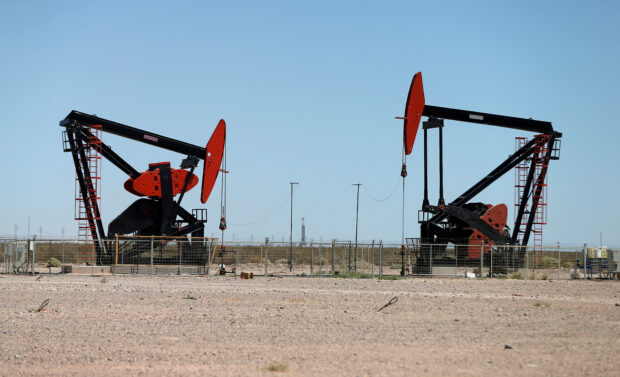
FILE PHOTO: Oil pump jacks are seen at the Vaca Muerta shale oil and gas deposit in the Patagonian province of Neuquen, Argentina, January 21, 2019. REUTERS/Agustin Marcarian/File Photo
Oil prices rose in early Asian trade on Thursday, extending gains from the previous session following a bigger-than-expected weekly withdrawal from U.S. crude storage and signaling from the U.S. Federal Reserve that it would start lowering borrowing costs in 2024.
Lower interest rates cut consumer borrowing costs, which can boost economic growth and demand for oil. The news also sent the dollar falling, which makes oil less expensive for foreign purchasers.
READ: With rate hikes likely done, Fed turns to timing of cuts
Brent futures rose 46 cents, or 0.6 percent, to settle at $74.72 a barrel by 0007 GMT. U.S. West Texas Intermediate (WTI) crude rose 48 cents, or 0.7 percent, to settle at $69.95.
The market rose last session on worries about the security of Middle East oil supplies after a tanker attack in the Red Sea.
A tanker in the Red Sea off Yemen’s coast was fired on by gunmen in a speedboat and targeted with missiles, the latest incident to threaten the shipping lane after Yemeni Houthi forces warned ships not to travel to Israel.
The U.S. Energy Information Administration (EIA) said energy firms pulled a bigger than expected 4.3 million barrels of crude from stockpiles during the week ended Dec. 8 as imports fell.
READ: Oil prices dive on big US crude stock build, record output
In its monthly report, the Organization of the Petroleum Exporting Countries (OPEC) blamed the latest crude price slide on “exaggerated concerns” about oil demand growth.
Brent futures have dropped about 10 percent since OPEC+ announced a new round of production cuts on Nov. 30. OPEC+ includes OPEC and allies like Russia.